|
|
|
More photos from our tour of Rome on Day 3.
The Monumento Nazionale a Vittorio Emanuele II (National Monument of Victor Emmanuel II) or Altare della Patria (Altar of the Fatherland) or "Il Vittoriano" is a monument to honour Victor Emmanuel, the first king of a unified Italy. It occupies a site between the Piazza Venezia and the Capitoline Hill. The monument was designed by Giuseppe Sacconi in 1895; sculpture for it was parceled out to established sculptors all over Italy. It was inaugurated in 1911 and completed in 1935.
The monument was controversial since its construction destroyed a large area of the Capitoline Hill with a Medieval neighbourhood for its sake. The monument itself is often regarded as pompous and too large. It is clearly visible to most of the city of Rome despite being boxy in general shape and lacking a dome or a tower. The monument is also glaringly white, making it highly conspicuous amidst the generally brownish buildings surrounding it, and its stacked, crowded nature has lended it several derogatory nicknames. Romans sometimes refer to the structure by a variety of irreverent slang expressions, such as "Zuppa Inglese", "the wedding cake", and "the false teeth", while Americans liberating Rome in 1944 labeled it "the typewriter", a nickname also adopted by the locals.
The monument, "chopped with terrible brutality into the immensely complicated fabric of the hill", is built of pure white marble from Botticino, Brescia, and features majestic stairways, tall Corinthian columns, fountains, a huge equestrian sculpture of Victor Emmanuel and two statues of the goddess Victoria riding on quadrigas. The structure is 135 m (443 ft) wide and 70 m (230 ft) high. If the quadrigae and winged victories are included, the height is to 81 m (266 ft). The base of the structure houses the museum of Italian Reunification.
The monument holds the Tomb of the Unknown Soldier with an eternal flame, built under the statue of Italy after World War I following an idea of General Giulio Douhet. The body of the unknown soldier was chosen by Maria Bergamas of Gradisca D' Isonzo before 1919 an Austrian-Hungarian village, whose only child was a deserter of Austro-Hungarian Army then a soldier of the Regio Esercito was missing in action during World War I; between 11 other bodies of unknown soldiers/sailors of the armed forces of the Kingdom of Italy. The body was transferred from Aquileia, where the ceremony with Bergamas took place to Rome in late October to early November of 1921.
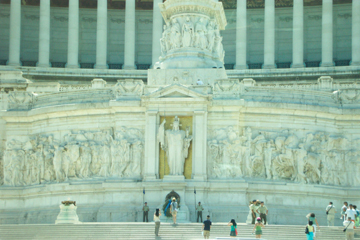 Emmanuel (Wedding Cake) Monument |
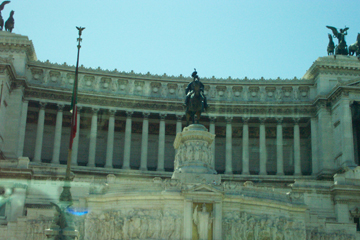 Emmanuel (Wedding Cake) Monument further |
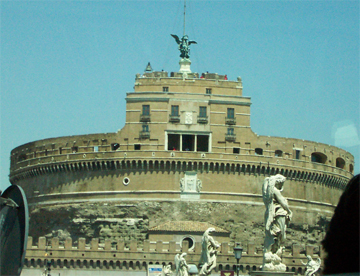 St Angelo's Castle |
 Ambulanza |
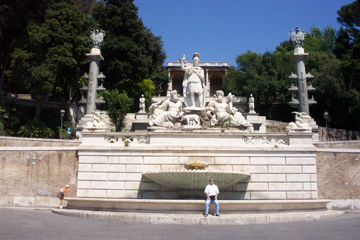 Sta Maria del Popolo Square Fountain during siesta time |
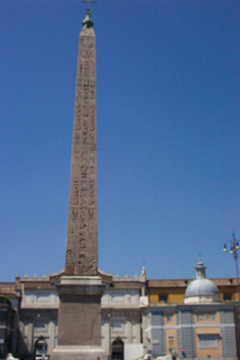 Obelisk-Sta Maria del Popolo Square |
 Obelisk-close up |
 Chiesa Saint Marie del Popolo |
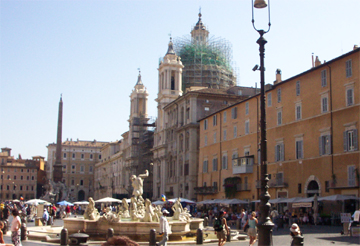 Navona Square - Fountain of the Four Rivers & church of Sant'Agnese |
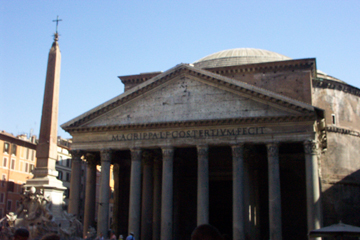 Pantheon |
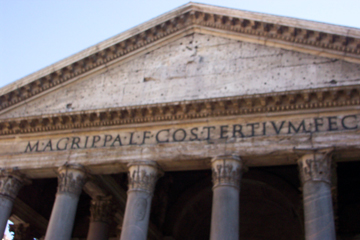 Pantheon Freeze |
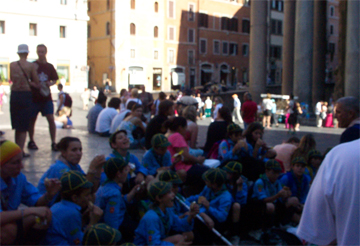 Scouts in front of Pantheon |
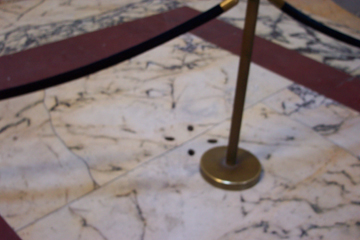 Drainage holes in floor under cupola in Pantheon. The Great Eye at the dome's apex is the source of all light. The oculus also serves as a cooling and ventilation method. During storms, a drainage system below the floor handles the rain that falls through the oculus. |
 View out of Pantheon |
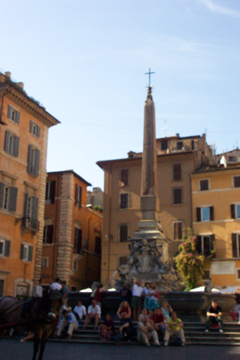 Pantheon Square (view from Pantheon) |
 Gelatto bar by Pantheon |
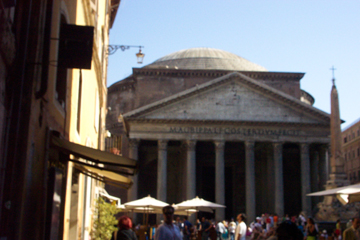 Pantheon view from Gelaterria |
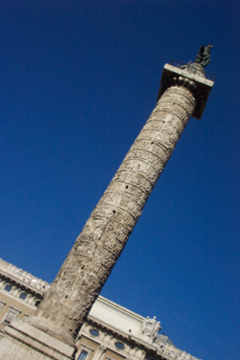 Obelisk with story going around it |
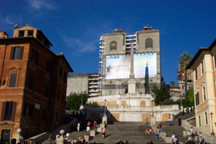 Spanish Steps |
 Pope gets raised up to hang flower rings on arm of statue |
 Street Performer |
Piazza Navona is a square in Rome, Italy. The piazza follows the plan of an ancient Roman circus, the 1st century Stadium of Domitian,[1] where the Romans came to watch the agones ("games"): It was known as 'Circus Agonalis' (competition arena). It is believed that over time the name changed to 'in agone' to 'navone' and eventually to 'navona'. It has sculptural and architectural creations: by Gian Lorenzo Bernini, the famous Fontana dei Quattro Fiumi (Fountain of the Four Rivers, 1651) in the center; by Francesco Borromini and Girolamo Rainaldi, the church of Sant'Agnese in Agone; and by Pietro da Cortona, who painted the gallery in the Pamphilj palace. Piazza Navona contains two additional fountains sculpted by Giacomo della Porta — the Fontana di Nettuno (1574), located at the northern area of Piazza Navona, and the Fontana del Moro (1576), located at the southern end of the piazza.
The Pantheon ("Temple of all the gods") was originally built as a temple to "all the gods" of Ancient Rome. The intended degree of inclusiveness of this dedication is debated. The generic term pantheon is now applied to a monument in which illustrious dead are buried. It is the best preserved of all Roman buildings, and perhaps the best preserved building of its age in the world. It has been in continuous use throughout its history. The design of the extant building is sometimes credited to the Trajan's architect Apollodorus of Damascus, but it is equally likely that the building and the design should be credited to the emperor Hadrian or his architects. Since the 7th century, the Pantheon has been used as a Christian church The Pantheon is currently the oldest standing domed structure in Rome.
The Spanish Steps (Italian:
Scalinata della Trinità dei Monti) climb a steep slope between the
Piazza di Spagna at the base and Piazza Trinità dei Monti, dominated by
Trinità dei Monti, the church that was under the patronage of the Bourbon
kings of France, above. The Scalinata is "without a doubt the longest and
widest staircase in all Europe". The monumental stairway of 138 steps was built
with French diplomat Étienne Gueffier’s bequeathed funds of 20,000
scudi,
in 1723–1725, linking the
Bourbon
Spanish Embassy to the
Holy See,
today still located in Palazzo Monaldeschi in the piazza below, with the Trinità
dei Monti above. The Spanish Steps have included a small cut-flower market. The
steps are not a place for eating lunch, being forbidden by Roman urban
regulations.
In the Piazza at the base is the
Early Baroque
fountain called
La Fontana della Barcaccia ("Fountain of the Old Boat"). According to an
unlikely legend,
Pope Urban VIII had the fountain installed after he had been impressed by a
boat brought here by a flood of the
Tiber
river.
http://en.wikipedia.org